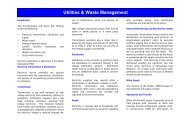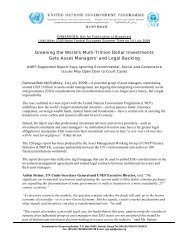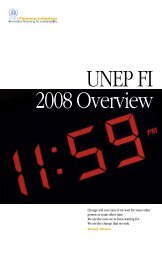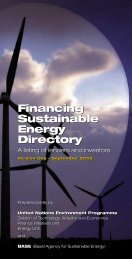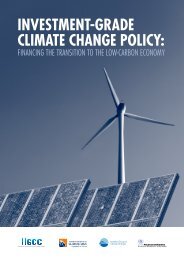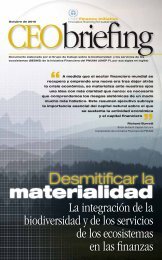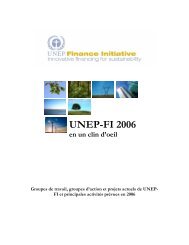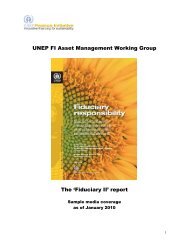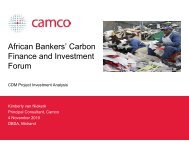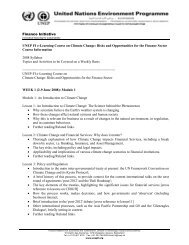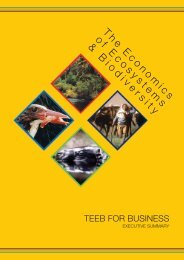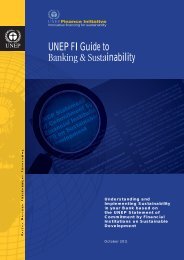Carbon 2009 Emission trading coming home - UNEP Finance Initiative
Carbon 2009 Emission trading coming home - UNEP Finance Initiative
Carbon 2009 Emission trading coming home - UNEP Finance Initiative
Create successful ePaper yourself
Turn your PDF publications into a flip-book with our unique Google optimized e-Paper software.
<strong>Carbon</strong> <strong>2009</strong><br />
Figure 3.19: Grading projects<br />
“In the voluntary market, grade each of the following project types on a 1 to<br />
5 scale in terms of value they are able to fetch in the market, all else being<br />
equal.” Question to companies with emissions regulated under RGGI or<br />
offset project developer/aggregator in North American market. N=63.<br />
Renewable Energy<br />
method, while fewer think the<br />
voluntary market presents a risk<br />
for compliance markets.<br />
Higher marks for<br />
voluntary markets<br />
in <strong>2009</strong> than in 2008<br />
Energy Efficiency<br />
When it comes to general<br />
evaluation, the voluntary market<br />
is also getting higher marks<br />
this year than last. This holds<br />
across the board, as Figure<br />
3.20 displays. The market is<br />
seen as more transparent and<br />
mature than last year, and more<br />
respondents also agree that<br />
voluntary emission reductions<br />
are real.<br />
There is also greater agreement<br />
that the voluntary market fosters<br />
innovation in emission reduction<br />
Figure 3.20: Assessing the voluntary carbon market.<br />
Share of respondents agreeing with the given statements (options 4 and 5).<br />
N=2853 (<strong>2009</strong>)<br />
50%<br />
Agricultural Methane<br />
Coal Mine Methane<br />
Industrial Gas (HFC, SF6, etc.)<br />
Enhanced Oil Recovery<br />
REDD/Avoided Deforestation<br />
Source: Point <strong>Carbon</strong><br />
Landfill Methane<br />
2008<br />
Reforestation<br />
Afforestation<br />
Soil Sequestration<br />
0 1 2 3 4 5<br />
Consequently, the voluntary<br />
market appears better positioned<br />
to provide US-eligible offsets this<br />
year than last, just as the US looks<br />
much more likely now to take a<br />
leadership position in the global<br />
carbon market than it did just a<br />
year ago.<br />
4. <strong>Carbon</strong> markets<br />
beyond 2012<br />
What is the outlook for carbon<br />
<strong>trading</strong> after 2012? In this section,<br />
we look to the future in dialogue<br />
with what our survey respondents<br />
think will happen in the long term.<br />
We start with a note about the<br />
plans for the EU ETS phase 3<br />
(2013-20) and then move quickly<br />
on to an analysis of the up<strong>coming</strong><br />
Copenhagen climate summit<br />
and the likely shape of the<br />
post-2012 international climate<br />
regime. Finally, we look at the<br />
consequences for global carbon<br />
<strong>trading</strong> in the long run.<br />
Share of respondents<br />
40%<br />
30%<br />
20%<br />
10%<br />
0%<br />
<strong>2009</strong><br />
The voluntary<br />
carbon market is<br />
transparent<br />
Source: Point <strong>Carbon</strong><br />
The voluntary<br />
carbon market<br />
produces real<br />
emissions<br />
reductions<br />
The voluntary<br />
carbon market<br />
fosters<br />
innovation in<br />
emission<br />
reduction<br />
methods<br />
The voluntary<br />
carbon market is<br />
more mature<br />
now than one<br />
year ago<br />
The voluntary<br />
carbon market<br />
poses a risk for<br />
the reputation of<br />
the compliance<br />
markets<br />
4.1 EU ETS phase 3<br />
With the deal struck in December<br />
2008, the EU has concluded on<br />
most key issues linked to phase 3<br />
of the EU ETS. The allocation will be<br />
reduced by 21 percent compared<br />
to 2005 by 2020, the amount of<br />
auctioning will increase compared<br />
to phase 2, and the credit limit,<br />
which is set for the 2008-2020<br />
period, is equal to 50 percent of<br />
the reduction effort. Outstanding<br />
issues include the determination<br />
30<br />
All rights reserved © <strong>2009</strong> Point <strong>Carbon</strong>



